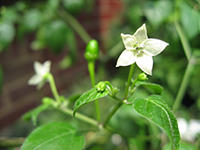
Flower of the Chili Pequin
photograph by H.M.Bennett
Jeff's Bird Pepper Sauce (JBPS) utilizes the pepper of the Capsicum annuum var. glabriusculum , commonly known as the Chili Pequin or the Bird Pepper. JBPS utilizes 7 in-ground plants and 2 potted plants. All peppers harvested for the sauce originate in Lewisville, Texas and from test specimens in East Texas. The pepper plants are water managed and organic fertilizer occasional applied. All peppers are hand harvested over the growing seasons. Pequin yield equals 1000 peppers per cup. Each 5 oz. bottle of JBPS contains an average of 300 Chili Pequins for the 300 Recipe and 50 Chili Pequins for the 50 Recipe.
The Chili Pequin is native to Texas and grown successfully in the North Texas area. A deciduous perennial that leafs in early spring, it begins flowering in late April to the middle of May. The flowers are white, about 1 cm in diameter with five (5) Petals and are bisexual. Wind tends to be the primary catalyst for pollination in late spring when Native and European bees are still scarce. Hand/finger pollination is a method that can be utilized in the absence of wind and insects during the onset of flowering. Successfully pollenated flowers will reorient the Pistil from a horizontal position to a vertical position within a few days of flowering. Unsuccessful pollination results in the flower yellowing at the base of the Pedicel near the stem. The pollinated Ovary will begin to enlarge as the Petals and Stamens dry up and fall off. The Chili Pequin is prolific with flowers until late July to early August if supplemental irrigation is provided. The peppers will remain on the plant during the August dormancy with some peppers turning red. Flowering resumes in mid-September and will continue until the plant is forced into winter dormancy by a hard freeze in mid-November to early December. There are two harvesting seasons for the Chili Pequin, once in mid-summer and once in late fall before the dormancy freeze. Trimming the Pequin after the first harvest will increase pepper yield in the fall. Chile Pequins with afternoon shade grow larger and have a greater yield of green peppers than red peppers. It is typical to have a large number of peppers that are in transition between green and red still on the plant when the dormancy freeze occurs. These peppers are lost to the winter. Trimming the Chili Pequin at the end of winter will accelerate new growth in the spring. It is possible that in a winter with multiple freeze cycles that the Pequin dies back to the root system or is killed all together and requires replacement.
Chili Pequins can be successfully planted in a pot but require more care than their in-ground counter parts. Potting will require more frequent watering and occasional fertilization as the plant becomes chlorotic. The Pequin is very resilient when it becomes under watered. As long as the Pequin is watered prior to the leaves becoming crispy, the leaves will rehydrate in a matter of hours after watering. The leaves and peppers in the Potted Pequin are also smaller than in-ground shrubs. It is important to overwinter the potted Pequins inside to prevent the pot from freezing. Potted Pequins overwintered inside will also retain most of their leaves and will have occasional flowers. There are two pests that attack the Chili Pequin, the Horn Tobacco Worm and Aphids. Aphids are predominantly problematic in potted Pequins. A typical in-ground plant will reach 5’x5’ while the plotted plant will average about 3’x3’ depending on pot size.
For more information on the Chili Pequin, please visit wildflower.org
The above text is original information based on over ten years of research and observation. If you intend to copy the above text in violation of the copyright, be kind and please correctly attribute this website and the author Jeffrey E. Bennett.
Revised 2015
The Logo can be dissected into three distinct symbolic messages: What the mockingbird is offering, what the bird has chosen and what the consequences of your choice will be if you chose JBPS.

J.E.Bennett
• The Mockingbird is carrying in his right foot the flower of the Chili Pequin, a reference to the creation of life, purity and peace. In his right foot, a Chili Pequin, a fruit that deceives its predator into consuming the fire and inflicting agony, this is the price of war and all will suffer.
• The Mockingbird’s head is turned to its Left. Had he turned its head to the right, an offer of peace would be a foot. Instead, he has chosen war.
• The Mockingbird forewarns of the impending results from consuming Jeff’s Bird Pepper Sauce. Water will not quench a flailed tongue.
Coming Soon...

